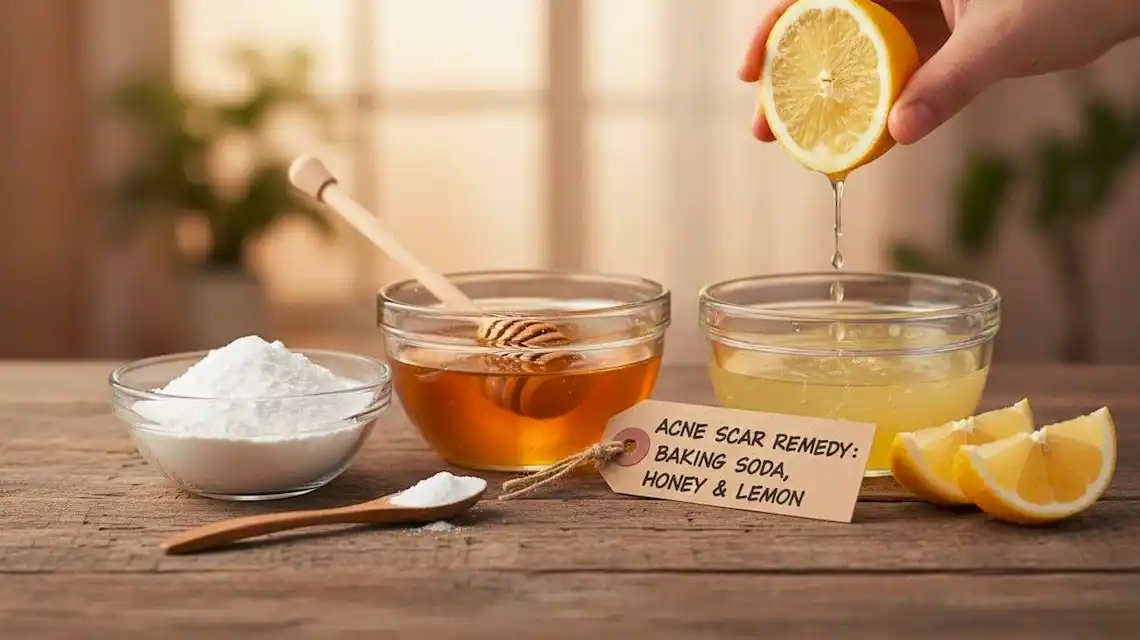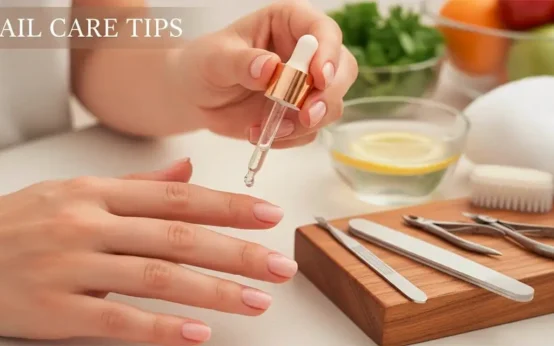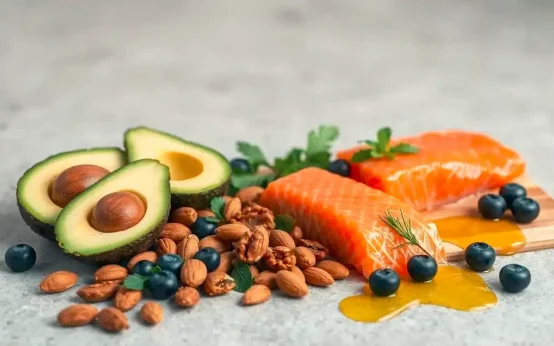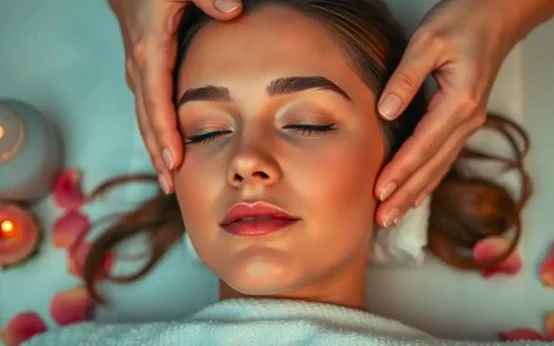Cheap kitchen fixes are trending for acne marks, and it is easy to see why. You likely have these ingredients in your pantry, and the promise feels simple. Try a mix of baking soda, honey, and lemon for acne scars, and watch dark spots fade. That is the dream. But here is the honest version: some people see mild brightening of dark marks, others end up with irritation or even darker spots. Medium to deep skin tones have higher risk for this.
This guide breaks down what these ingredients can and cannot do. You will learn the quick science, safety rules, step-by-step methods, realistic results, gentler alternatives, and when to see a dermatologist. If you remember one takeaway, let it be this: these can help a little with color only, not dented scars, and sunscreen is non-negotiable.
Does baking soda, honey, and lemon fade acne scars or just hype?
Let’s define the problem first. People use the word scar for two different things. True acne scars change skin texture. They look like dips, pits, or rolling uneven areas. Acne marks are color changes, not texture changes. These include brown spots, called post-inflammatory hyperpigmentation, and red or pink marks, called post-inflammatory erythema.
Most home remedies, including pantry mixes, mainly target color. They do not rebuild collagen or lift dents. That is why pitted or ice pick scars need in-office care over time.
Here is the high-level science on each ingredient:
- Baking soda is very alkaline. Skin prefers a slightly acidic pH. Baking soda can strip the barrier and act like a rough scrub. This can cause irritation or trigger more dark spots on some skin types.
- Honey is a natural humectant. It helps skin hold water. It also has soothing and mild antibacterial properties. Manuka honey has more research behind it than regular honey.
- Lemon juice contains citric acid and natural vitamin C. It can brighten a bit, but it often stings and may cause sun sensitivity or blotchy darkening if used without care.
There are no strong clinical trials on this exact combo for acne marks. Most evidence is anecdotal. When results do happen, they tend to be mild and slow, and more for brown spots than texture.
Bottom line: with careful use, you may see slight brightening of dark marks. Do not expect pitted scars to change. If you try anything at home, keep it gentle, short, and always follow with sunscreen.
Using the trio of baking soda, honey, and lemon for acne scars can be tempting, but approach with caution.
What kind of acne marks can home remedies help?
- PIH (brown spots): Color left after a blemish heals. These often fade over months. Gentle care and sun protection help.
- PIE (pink or red marks): Redness from lingering inflammation or dilated vessels. These can fade, but they may take longer.
- Atrophic scars: Texture changes like ice pick, boxcar, or rolling scars. Kitchen remedies will not fill these in.
Set your goal around tone, not texture, if you try home methods.
How each ingredient works on skin
- Baking soda: Very alkaline, can disrupt the skin barrier if overused. Acts as a physical scrub. Risk of dryness and irritation is real.
- Honey: Humectant that helps skin hold water. Soothing and antibacterial for many people. Manuka has more supportive data.
- Lemon: Contains citric acid and natural vitamin C. Can sting and increase sun sensitivity. Patch test is essential.
Quick caution: mixing all three can be harsh. The pH clash, plus abrasion, increases the odds of irritation.
Pros and cons at a glance
Pros:
- Low cost and easy to find
- Honey is gentle for many skin types
- Mild brightening possible for dark spots
- Short contact times can reduce risk
Cons:
- Baking soda can damage the barrier
- Lemon can burn or darken skin with sun
- Uneven results, especially on sensitive skin
- Higher risk for medium to deep skin tones and reactive skin
Takeaway: if you try it, keep it simple. Use one ingredient at a time and stop at the first sign of irritation.
Who should avoid this mixture
- Sensitive or reactive skin
- Eczema or rosacea
- Medium to deep skin tones with a history of PIH
- People using retinoids, benzoyl peroxide, or acids
- Anyone with open cuts, broken skin, or active cystic acne
- Anyone who will be in strong sun soon
Safer swaps and better options are listed later in this post.
How to try baking soda, honey, and lemon safely at home
Safety first. If you want to try a pantry approach, start small. Patch test. Use one ingredient at a time. Limit contact time. Rinse well, moisturize, and use SPF 30 or higher daily. If it stings or feels tight, that is a sign to stop.
Short, gentle sessions reduce the chance of peeling or darkening. You can always do more later, but you cannot undo a burn.
Patch test and setup
Patch test steps:
- Apply a tiny amount behind the ear or on the inner arm.
- Leave on for 10 minutes.
- Rinse and pat dry.
- Watch the area for 48 hours for redness, itching, bumps, or darkening.
Gather your tools:
- Mild cleanser
- Clean bowl and spoon
- Soft towel
- Fragrance-free moisturizer
- Mineral or chemical sunscreen SPF 30 or higher
Safer DIY recipes and ratios
- Honey-only mask
Spread a thin layer of raw or Manuka honey on clean skin for 10 minutes, then rinse. Good for soothing and hydration. This is the safest option. - Baking soda spot paste
Mix 1 part baking soda to 8 parts water. Apply only to a dark mark for 30 to 60 seconds, then rinse fully. Use at most once per week. Do not scrub. - Lemon alternative
Avoid straight lemon juice on skin. If you insist, dilute 1 part juice to 10 parts water. Apply with a cotton tip to a single dark spot for 60 seconds max, then rinse and moisturize. A better option is a store-bought vitamin C serum at 10 to 20 percent. Do not mix all three at once.
Step-by-step routine and frequency
Night routine:
- Cleanse
- Apply your chosen method to spots only
- Rinse well and pat dry
- Moisturize
Morning routine:
- Cleanse if needed
- Moisturize
- Apply broad-spectrum SPF 30 or higher
Frequency guide:
- Honey: up to 2 to 3 times per week
- Baking soda: no more than once per week
- Lemon alternative: no more than twice per week if tolerated
Do not use on the same night as retinoids or acids.
Results to expect and timeline
Mild PIH may look a bit lighter in 4 to 8 weeks if you stay consistent and use sunscreen. PIE and deep scars take more time and usually need pro care. If you see darkening, stinging, or peeling that lasts beyond a day, stop and switch to gentler options.
Sunscreen is the biggest factor in fading. UV exposure keeps pigment active, so daily SPF matters more than any single mask.
Side effects, risks, and when to stop using baking soda, honey, and lemon
Let’s be clear about risks. Baking soda can disrupt your barrier, which leads to dryness, redness, and more breakouts. Lemon can sting or cause phototoxic reactions if you go in the sun. Honey allergies are rare, but they exist. Irritation often leads to more PIH, especially for medium to deep skin tones.
Stop immediately if you feel burning, see hives, or notice new dark patches. Rinse with cool water, switch to bland care, and avoid sun exposure. If severe symptoms show up, see a clinician.
Keep things clean. Use a clean bowl and spoon, and do not dip fingers into jars. Make only what you will use once, then discard. Store honey sealed at room temp. Do not store diluted lemon juice or baking soda mixes.
Common reactions and how to calm skin fast
Typical signs of trouble:
- Tightness, burning, or stinging
- Redness or flaking
- Darker marks after a day in the sun
Immediate care:
- Stop actives right away
- Rinse with cool water
- Use a bland moisturizer with ceramides or petrolatum
- Skip makeup and sweaty workouts for the day
- Apply SPF and avoid mid-day sun
Red flags that need a doctor
- Blistering, swelling, severe pain
- Oozing or a spreading rash
- Rapidly dark patches
- Eyes or lips involved
If you are on prescription acne meds, ask your dermatologist before using DIY acids or scrubs.
Better evidence-based options for acne scars and dark spots
Gentle, proven picks for color:
- Azelaic acid 10 to 15 percent
- Niacinamide 4 to 5 percent
- Vitamin C serum 10 to 20 percent
- Daily sunscreen SPF 30 or higher
For texture over time:
- Adapalene 0.1 percent or retinol at night if not pregnant
- Weekly lactic acid or PHA at low strength
Do not stack multiple actives on the same night.
In-office treatments that work faster
- Microneedling for rolling or boxcar scars, 3 to 6 sessions, low downtime
- Chemical peels for PIH, 2 to 4 sessions
- TCA CROSS for ice pick scars, 2 to 4 sessions
- Subcision for tethered scars, often paired with filler
- Fractional laser or RF microneedling for mixed scars
Costs and outcomes vary by clinic and skin type. A consultation helps match the plan to your skin.
A safer plan to fade acne marks without harsh kitchen acids
You do not need to risk burns to make progress. A gentle plan works better over time and fits a busy week. Use one brightener, one active if your skin can handle it, and sunscreen every morning. Add honey as a soothing option if you like it. This path is low risk and still gets results.
Using baking soda, honey, and lemon for acne scars might feel quick, but a steady routine will outpace harsh mixes in most cases.
7-day starter plan and product checklist
Simple schedule:
Morning:
- Gentle cleanser
- Niacinamide or vitamin C
- Moisturizer
- SPF 30 or higher
Night:
- Gentle cleanser
- Azelaic acid or adapalene on alternate nights
- Moisturizer
Optional:
- Honey mask twice per week on clean skin for 10 minutes
Checklist:
- Gentle cleanser
- Bland moisturizer
- SPF 30 or higher
- One brightener (niacinamide or vitamin C)
- One active (azelaic acid or adapalene)
- Cotton tips for spot work
- Notebook to track changes
Can I mix baking soda, honey, and lemon together?
Short answer: no. The pH conflict and combined irritation risk outweigh any benefit. If you still want to try something, test one ingredient at a time and only on a single dark spot. Remember, sunscreen and time do more for PIH than any harsh mix.
Teens, pregnancy, active acne, and daily use
- Teens: keep it gentle, skip harsh scrubs, stay consistent with SPF.
- Pregnancy: skip retinoids, and check with a clinician about acids. Azelaic acid is often used but confirm first.
- Do not use lemon mixes daily.
- Do not apply to broken skin or active cysts.
- For active acne, consider benzoyl peroxide or adapalene if appropriate, plus azelaic acid for marks.
Key takeaways and a short do and don’t list
Do:
- Patch test
- Try honey first
- Dilute and limit contact time
- Moisturize
- Use SPF every morning
Don’t:
- Mix all three
- Rub hard
- Use on open pimples
- Use before sun exposure
- Keep using if you see burning or darker spots
Reminder: baking soda honey and lemon for acne scars may help a little with color, but gentle science-backed care does more with less risk.
Conclusion
Kitchen fixes can offer minor brightening for dark marks, not deep scars, and the risks are real without careful use. If you want to try something at home, start with honey, patch test, and protect your skin every morning. A steady plan with sunscreen, niacinamide or vitamin C, and azelaic acid gives safer, lasting results. For stubborn spots or any textured scars, a dermatologist can guide you on treatments that actually rebuild collagen. Used wisely, baking soda honey and lemon for acne scars belongs in the maybe pile, while sunscreen and proven actives belong in your daily routine.
Related post:
- How to Treat Acne Scars at Home Naturally
- Best Post Acne Routines That Really Work (Simple Guide)
- Natural Remedies for Hormonal Skin Problems
FAQs: Baking Soda, Honey, and Lemon for Acne Scars
Do baking soda, honey, and lemon actually fade acne scars?
They may help with discoloration a little, but they won’t fix true indentations. Honey can calm skin. Baking soda and lemon often irritate, which can make marks worse.
What’s the difference between dark spots and true scars?
Post-acne dark spots are pigment changes, not raised or indented scars. Atrophic scars are pits or depressions. Home remedies rarely change texture. Dark spots may fade with time and sunscreen.
Is lemon juice safe for acne marks?
It’s acidic and can burn or sting. It may trigger irritation, peeling, or post-inflammatory hyperpigmentation, especially on medium to deep skin tones. Dermatologists usually advise against direct lemon on skin.
Is baking soda safe to use on the face?
It’s very alkaline and disrupts the skin barrier. This can cause dryness, redness, and more breakouts. It’s not recommended for facial use.
Does honey help with acne scars?
Honey is soothing and has mild antibacterial action. It can support healing and reduce redness. It will not remove indented scars, but it may help skin look calmer.
Can I mix baking soda, honey, and lemon together?
Avoid mixing all three. The pH swings are harsh, and the combo often irritates. If you want a simple option, use plain honey as a short mask.
How should I patch test first?
Apply a tiny amount behind the ear or on the jawline. Wait 24 to 48 hours. Stop if you see burning, swelling, or a rash.
How often can I use these at home?
If you use honey, try 10 to 15 minutes, 2 to 3 times weekly. Avoid routine use of baking soda and lemon on your face. If irritation starts, stop right away.
Can I leave these on overnight?
Do not leave baking soda or lemon on overnight. Honey can be left longer, but it can be messy. Start with short contact times.
Will lemon lighten dark spots faster?
Not reliably, and the risk of irritation is high. Use daily sunscreen and proven brighteners instead, like azelaic acid or niacinamide.
What should I use instead for acne marks?
Try SPF 30 or higher every day, azelaic acid, niacinamide, vitamin C, or retinoids. For texture scars, consider chemical peels, microneedling, subcision, or laser with a professional.
Are there risks for darker skin tones?
Yes. Lemon and baking soda can trigger hyperpigmentation. Stick to gentle products and sun protection. Azelaic acid is a good option for pigment.
Can I use these with retinoids or acids?
Avoid combining lemon or baking soda with retinoids, AHAs, or BHAs. The mix can irritate and inflame skin. Space active products and keep routines simple.
Is this safe during pregnancy or breastfeeding?
Topical honey is generally safe. Lemon juice can irritate, and baking soda is not advised. Check any leave-on actives with your clinician.
Should I use fresh lemon juice or bottled?
Neither is a great idea for skin. If you want vitamin C benefits, pick a well-formulated serum from a reputable brand.
What about raised or keloid scars?
Home remedies will not help raised scars. Talk to a dermatologist about silicone gels, steroid injections, or other treatments.
What aftercare helps prevent new marks?
Use SPF daily, avoid picking, and keep breakouts controlled. Gentle cleansers, moisturizer, and non-comedogenic sunscreen support healing.
When should I see a dermatologist?
If scars bother you, if you have frequent irritation, or if dark spots persist more than 3 to 6 months. Early care prevents deeper marks.
Quick safer routine if you’re curious to try something simple
- Short honey mask, 10 minutes, rinse with lukewarm water.
- Daily sunscreen, SPF 30 or higher.
- Add one proven brightener, such as azelaic acid, a few nights weekly.
- Stop if stinging or peeling starts.




 How To Remove Sun Tan From Hands
How To Remove Sun Tan From Hands  How to Take Care Your Nails
How to Take Care Your Nails  How to Improve Good Cholesterol (HDL)
How to Improve Good Cholesterol (HDL)  Hormone Health Tips for Women
Hormone Health Tips for Women  Heal Dry Damaged Hair: A Simple Plan That Works
Heal Dry Damaged Hair: A Simple Plan That Works  How to Look Much Younger Without Drastic Changes
How to Look Much Younger Without Drastic Changes